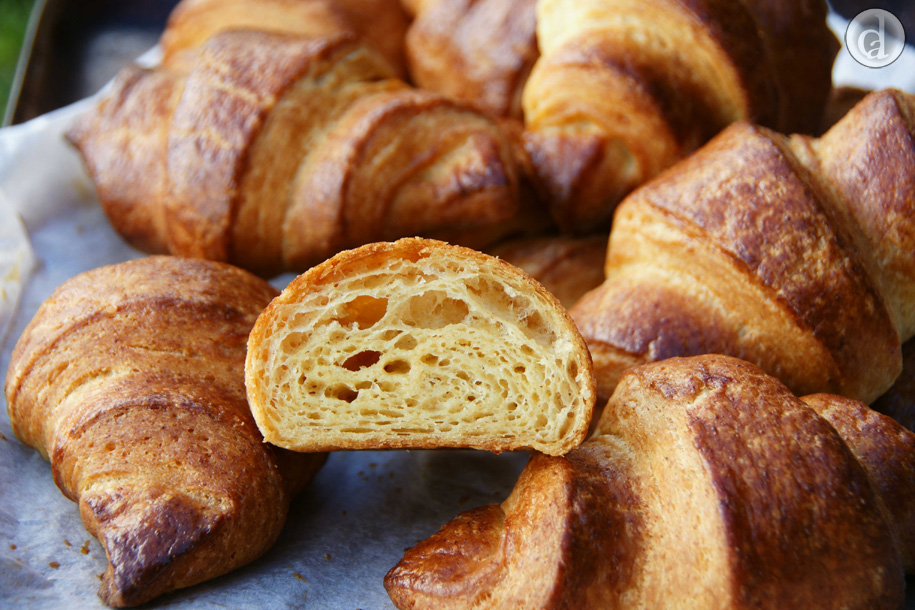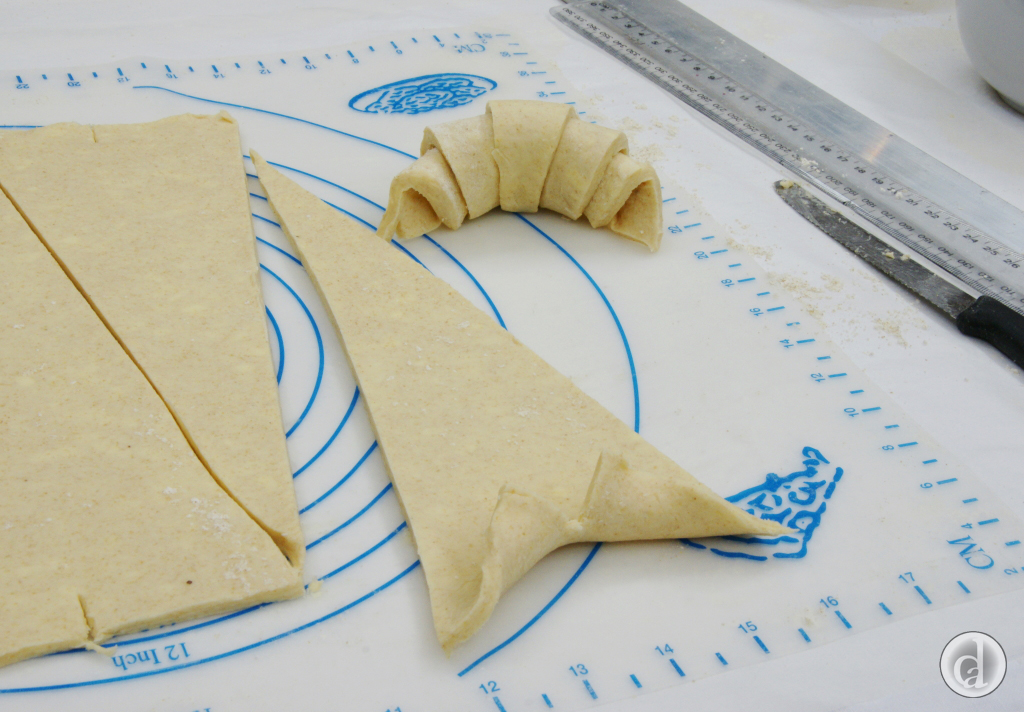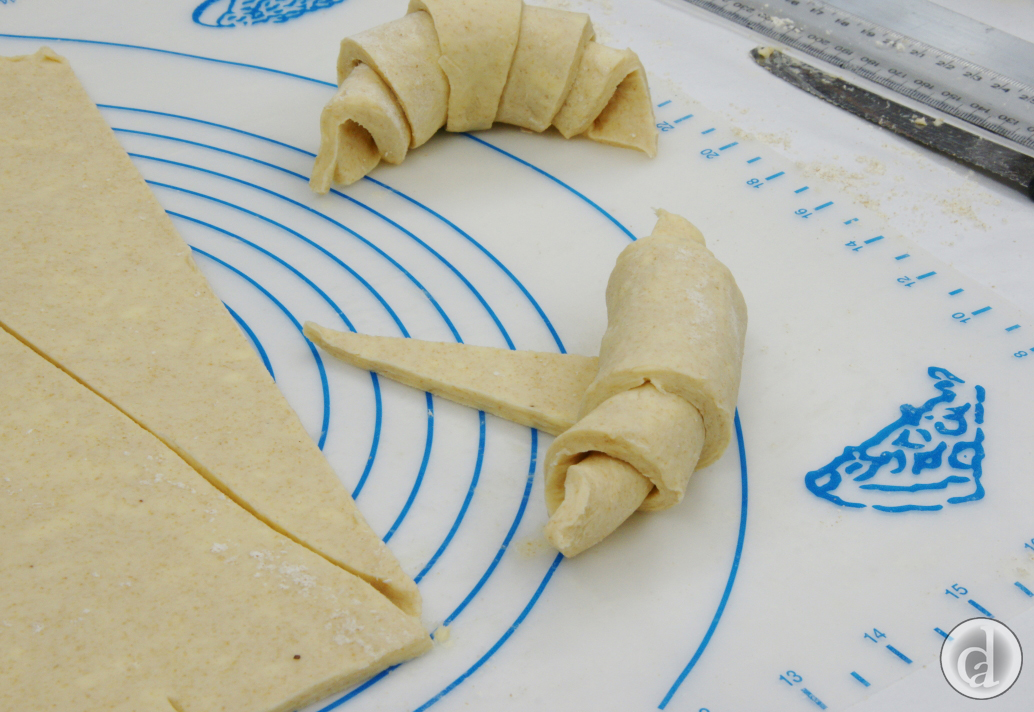No Gum GF Croissants

Yeasted pastries - I love them. If you are looking at this recipe you probably do to.
They are relatively easy to make, bake & super easy to eat.
However, if you are feeling hesitant about making them because you think they might be hard make some gluten free Puff Pastry first.
This recipe was designed specifically to be made with Bakers' Magic gluten free flour. The finished baked product will not be the same if you use another gluten free flour and you will need to adjust the recipe, particularly if the flour you're using contains rice flour.
Ingredients
400 g Bakers' Magic Gluten free flour
75 g Sugar
2 tsp Yeast
1/4 - 1/2 tsp Salt
150 g Boiling water
250 g Water (bit cooler than room temperature)
50 g Melted butter
Extra BM gf flour
Butter Block
~330 g Butter at room temperature
Egg wash
1 Egg
~1/4 tsp Salt

Method
Stand mixer - can also be mixed by hand but it is a bit hard getting all the lumps out. I've made it a couple of times in a Thermomix however the resulting pastry tends to be slightly harder & not as crisp. My preferred method is using a stand mixer.
There is no way getting around it - you have to work reasonably quickly after the dough is taken from the freezer as the yeast will be active at room temperature.
Put the boiling water & the cooler water in a jug.
Put 100 g of the water into a small bowl, stir in 15 g of sugar & the yeast. Let it sit for ~ 5 mins. If the yeast is active continue making the croissants.
Mix together the Bakers' Magic Gluten free flour, remaining 60 g of sugar & salt.
Melt the butter in another container. Add the remaining 300 g of water to the butter.
Pour the butter/water and the active yeast on to the flour & mix on low/medium until it is uniform.
At first the dough will be really runny - don't worry it will thicken.
Put the dough onto some water proof wrapping (plastic clingfilm, bees wax wrap), flatten, cover completely & leave at room temperature for approximately 30 mins. Transfer to the freezer for 30 mins.
Use some of the extra Bakers' Magic Gluten free flour to lightly flour a clean work surface & rolling pin. If you have a pastry mat put a piece of A4 paper underneath it - you'll use it as a guide when rolling out the dough.
Transfer the dough to the floured surface. Put a little flour on the top.
The dough is going to be rolled out & folded (6 single turns - check out Information - gluten free flaky pastry) BEFORE the butter block is added.
Why before?
- The dough likes to be kneaded.
- It helps shape the dough into a rectangle.
- You can practice the rolling & folding without the pressure of having added butter.

Roll out the dough into a rectangular shape the size of the A4 paper (mine is a bit neat - it doesn't normally look like that on the first roll). I usually lift the dough up every now & then & put a bit more flour to prevent it sticking to the work surface.

Fold in one long side of dough approximately one third, fold the other long side over the top. This is a 'single turn'.
 Turn the folded up dough 90 degrees and roll it out to the size of the A4 sheet. Repeat the folding up. This is the second single turn. If the dough is a little sticky put a little flour on top & then brush off the excess. Repeat the folding & rolling out for another 4 single turns.
Turn the folded up dough 90 degrees and roll it out to the size of the A4 sheet. Repeat the folding up. This is the second single turn. If the dough is a little sticky put a little flour on top & then brush off the excess. Repeat the folding & rolling out for another 4 single turns.
Adding the butter block
Roll out the dough to the size of an A4 piece of paper.

Put the butter between 2 sheets of baking paper. The butter should be soft(ish). We want the butter to be 2/3rds of the size of the dough and soft enough to be able to be rolled out.

I usually whack it with a rolling pin to make it thinner. I then shape the butter between the baking sheets with my hands.

Take off the top layer of baking paper & place the butter block on to the left hand side of the rolled out dough. Remove the bottom piece of baking paper that is now on the top of the butter.
 Fold the right hand side of the dough (no butter on it) over the middle third of the dough. Repeat with the either side.
Fold the right hand side of the dough (no butter on it) over the middle third of the dough. Repeat with the either side.
Ensure that all butter is encased in dough. If it isn't pinch/stretch some of the dough to enclose the butter.
Turn the dough 90 degrees and roll out to the size of an A4 piece of paper.
Fold & roll out the dough for 5 'single turns'. If the dough gets sticky add a little of the extra flour, brush off any excess.

Roll out the dough to a thickness of 4 mm & a width of > 25 cm. To ensure the dough is an even thickness follow this tip. Find 2 placemats (dinner setting - my placemats are ~4 mm thick) place one on either side of the dough. I have thrown away my cardboard pieces & now have stainless steel spacers 1 mm, 2 mm & 3 mm thick - they are much easier to clean. When rolling out the dough ensure the rolling pin is wide enough to span the dough and part of the top of the placemats. My rolling pin is large – 61 cm from handle to handle. If your rolling pin is smaller it may be easy to half the dough. Initially when rolling the pin may not necessarily rest on the placemats, however, when the dough is the same thickness as the placemats it will. At this stage the dough should be all the same thickness.

Trim the long edges of the dough but keep the width of the rolled dough > 25 cm. Keep the off cuts. Don't worry too much about trying to get the long ends of the dough to a thickness of 4 mm. When cutting out the croissants the edges get cut off.
Use a knife to mark every 5.5 cm along both long sides. Cut the dough into triangles by cutting from one notch on one long side of the dough to the next notch on the other side.

Each triangle will be ~11 cm at the base & ~ 25 cm in length. There should be sufficient dough to make 8 croissant triangles.
There will be a nick in the middle of the base of the triangle. Use a knife to make this nick slightly bigger.
Brush the top of each dough triangle down the middle with egg wash. The egg wash helps the layers stick together during baking.
Now you have have the choice of either rolling up the dough & proving or proving & then rolling up the dough.
You get better croissants when you prove the dough then roll it up however it isn't as easy as rolling up the dough & then proving.
Proving then rolling-up.
Line two baking trays with baking paper.
Transfer the triangles to the trays.
Prove the egg washed triangles for 15 - 30 mins. The proving time will depend on the temperature. The proving temperature can not be above 30 C otherwise the butter will start melting & you will lose some of the layers in the finished product. I usually prove the dough in the oven with a roasting dish containing hot (but not too hot) water in it (I also put a thermometer in there to check the temperature).
Brush the top of each dough triangle down the middle with egg wash again.
Gently roll up the dough to form the uncooked croissants following the instructions below. The dough will be relatively soft (depending on the proving temperature) and it is easy to squash the layers.
Rolling-up then proving.
Lift up one of the triangles to separate it from the other dough. Separate the nick at the base of the dough triangle & roll up the dough. The nick helps to make the crescent shape. Tuck the end of the triangle underneath the base of the croissant to stop it from unravelling.


Line a baking tray with baking paper.
Transfer the uncooked croissants to the baking tray.
Gently lay the off cuts on top of each other & roll this dough out to be 4 mm in thickness. Either cut out more triangles or cut out rectangles to make some chocolate croissants. At this stage I find it easier to cut out rectangles.
Allow the uncooked croissants to proof for approximately 15 mins. The proofing temperature can not be above 30 C otherwise the butter will start melting & you will loose some of the layers in the finished product. I proof the uncooked croissants in the oven with a roasting dish containing hot (but not too hot) water in it (I also put a thermometer in there to check the temperature).
If proofing in the oven take the tray out & turn oven on to 180 C.
After proofing the uncooked croissants will not look like they have risen a great deal. If the croissants are proofed for longer the layers may disappear in the cooked product. If the croissants are proofed for less the yeast flavour is not as pronounced.
Bake the croissants for ~25 mins at 180 C, turning the tray halfway through baking. The time will depend on your oven & the size of the croissants (& whether they have anything in them).
Simply enjoy!

